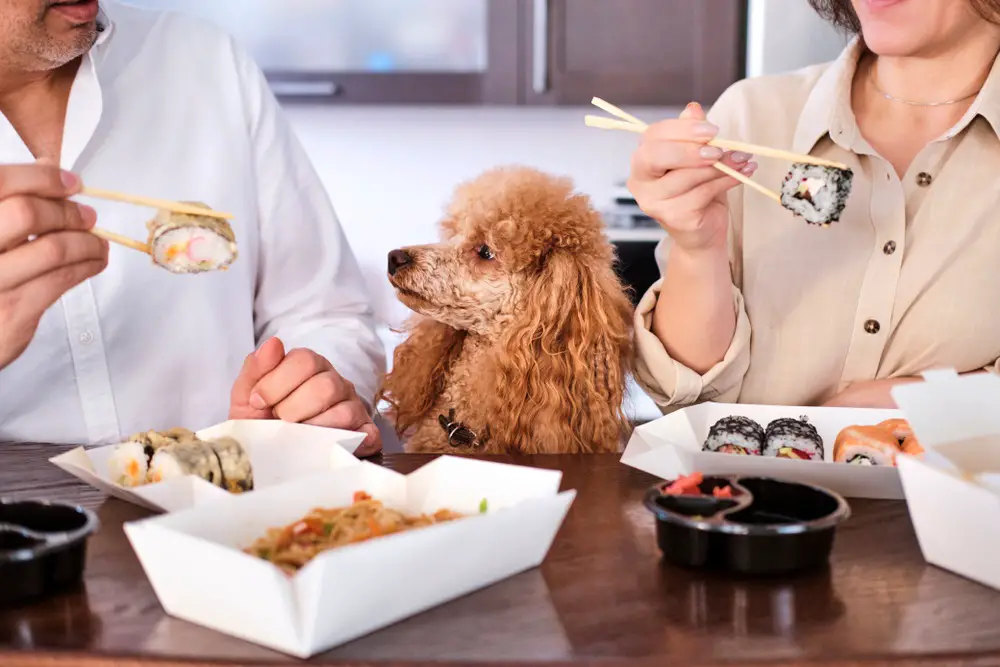It’s a common misconception that dogs are carnivorous. In actuality, we are omnivores. This means that our diet must consist of both meat and plant-based foods.
We have evolved to be able to break down plants inside our bodies, meaning that we can eat a huge variety of foods.
You might be surprised to learn that most of our foods already contain a percentage of brown rice. All good quality foods should contain a mixture of grains to ensure we are getting sufficient nutrients and fiber.
Brown rice is an easily digestible source of carbohydrates and contains many B vitamins and other minerals necessary to maintain good overall health.

Both B vitamins and vitamin D are essential to cardiovascular health in dogs. Calcium, iron, and riboflavin are also found within brown rice.
Calcium is vital to bone and teeth development and also plays a crucial role in cell signaling. Iron is used to metabolize energy and synthesize various components of blood.
We can eat both brown and white rice, although experts say that brown rice is more beneficial for our health.
This is because it has not been processed to remove the hull and bran (the outer layers of the rice grains). This means that brown rice contains more fiber and oil than white rice.
Can I feed my dog rice every day?
Yes, it’s perfectly fine to feed us a little brown rice every day. That is of course, provided you follow the 10% rule. If you feed us too much it can lead to weight gain and serious health problems down the line.
We do appreciate variety though, so my personal opinion would be to limit rice to 2 to 3 times per week. This ensures we are not being overloaded with fiber and allows us to have a more diverse range of food options.
I’m a Husky, so my body can handle roughly ¼ cup of brown rice daily. Smaller dogs, like my Chihuahua pals, can only really handle about a tablespoon of rice.
This should be fed to us as part of a varied and well-balanced diet, and should never be given in place of a complete meal.
Generally speaking, the calories from rice should never exceed 10% of our daily calorie intake.
How should you prepare rice for your dog?
While we have strong digestive systems, there are certain human foods that our bodies simply cannot handle.
This includes most seasonings such as salt and spices. It also applies to fatty substances such as butter and oil.
When you are preparing rice for your dog, you must cook it in just water. The easiest way to do this is in a rice cooker, but a pan would work too.
Do not add anything to the rice, simply serve it to us plain. This will ensure that you do not give your pup a stomach problem and helps with weight maintenance too.
Is it okay to give a dog rice for diarrhea?
Yes, it is. The easily digestible nature of rice means that it can be helpful in soothing our doggy stomachs.
The fiber and nutrients contained within the rice will help to restore natural balances within your dog’s body that have been destroyed by the diarrhea. It also helps to bind our poop together, meaning that diarrhea disappears more quickly.
Vets tend to recommend a 50:50 ratio of cooked rice to cooked lean meat such as chicken or reduced-fat beef. This is a delicious meal and no dog can resist!
It is not the most complete nutrient source and this should not become your dog’s standard diet. However, it is the perfect food source for dogs struggling with diarrhea and other digestive issues in the short term.
You can feed us brown rice in cases like this, but often the better option is white rice. It is slightly easier to digest and contains more starch.
That being said, it has a higher glycemic index than brown rice and can cause spikes in our blood sugar levels. If this is something that you are concerned about please contact a veterinarian before feeding rice to your dog.
What can I give my dog instead of rice?
For the first 24 hours following a bout of diarrhea, you should fast your pup. This is the worst part of us being ill and we will probably be upset, but it’s for the best. This first day you should only give us water. This allows our stomachs a chance to settle.
A great way to get some nutrients and hydration into us is by giving us bone broth. The smell and taste are enticing and we will get a lot of fluids from it too.
Since humans have jumped on the trend, bone broth is widely available on the market, or you can make your own.
You can also feed us small portions of bland foods such as boiled chicken. There should be no skin or bones attached. Other lean meats like beef, quail, lamb, or venison would work too.
Eggs, oatmeal, boiled potatoes, and plain tapioca pearls are great sources of starch. They are all easy to digest and will not put too much strain on your dog’s digestive system.
How much rice do you give a dog with diarrhea?
When your 24 hour fast period has ended you can begin to reintroduce your dog to food. The best idea is to boil some chicken and remove all of the fat, skin, and bones. Combine this with plain, boiled rice.
This should be done in a 2:1 ratio, meaning that the rice makes up a third of the portion size. It is a good idea to feed us multiple smaller meals instead of one or two larger ones.
When I’m ill, I like 3 or 4 meals that are about a cup each. This is the perfect amount for me to eat and feel satiated, without feeling nauseous from being overly full.
